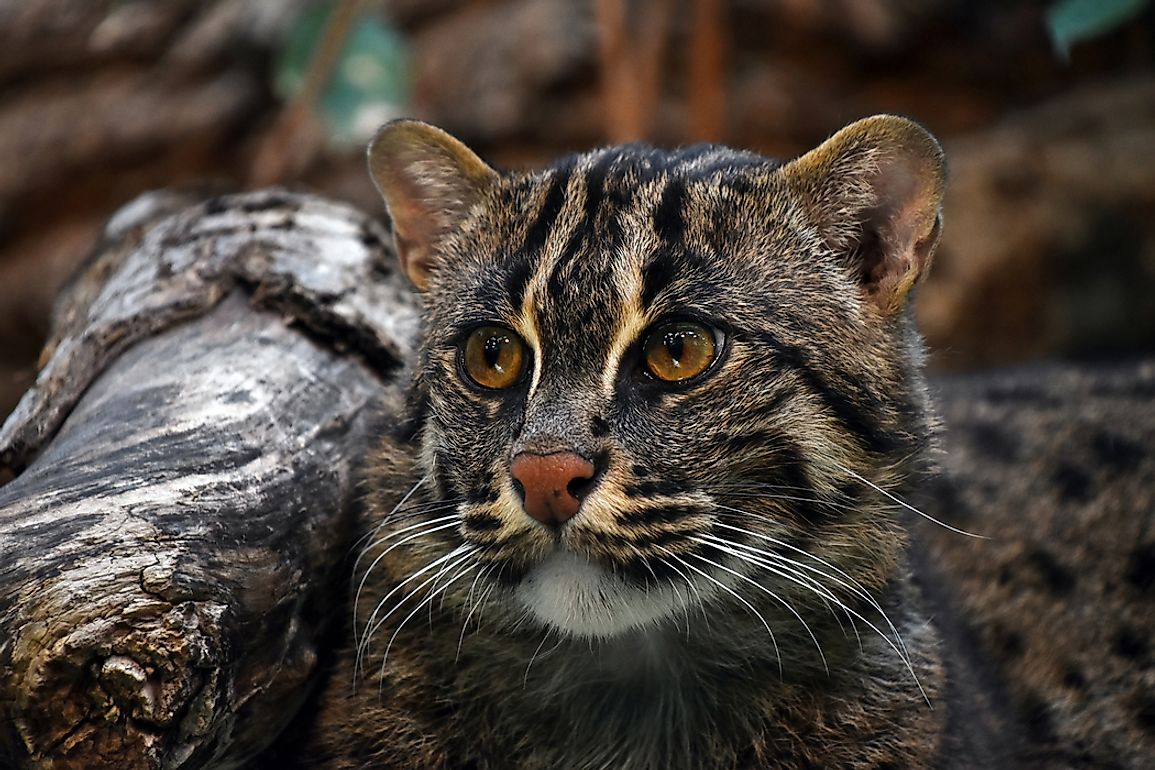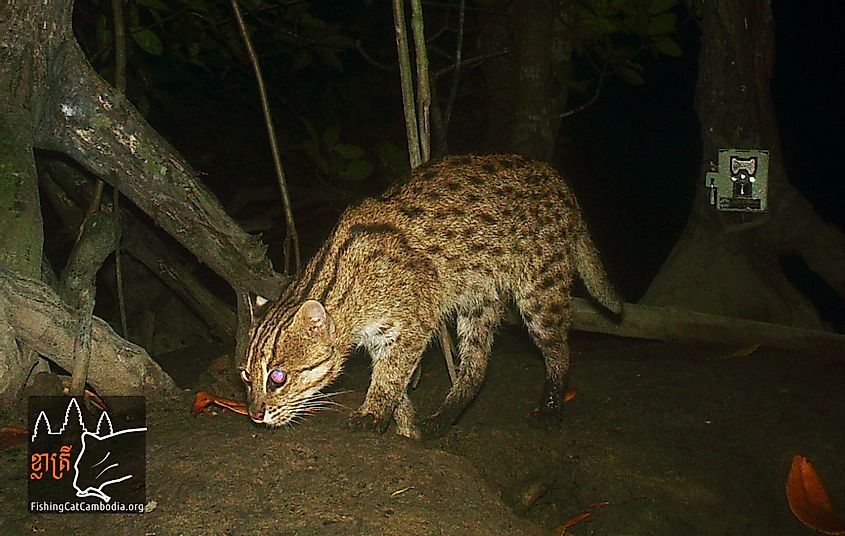Combat For Survival In Cambodia: The Case of the Fishing Cat

For most of us, the word “cat” brings to mind the domestic cat in our homes, or the majestic big cats like tigers,
leopards, and cheetahs roaming in the wild. When it comes to big cats in particular, most of us are aware of the
conservation needs of these species, and how, fortunately, actions are being taken across the
world to protect them. However, our planet is home to several
other felids like the fishing cats whose elusive nature makes them difficult to
spot in the wild.
“Out of sight, out of mind” often results in low levels of awareness about the need to protect these small cats. With a vanishing prey base and degrading habitats, these cats face the same threats to survival as their larger counterparts. They are also subject to the greed and wrath of humans who poach them or persecute them for their own interests. In this article, we try to inspect the threats facing the fishing cats and the initiatives taken to conserve them in Southeast Asia, with emphasis on Cambodia where populations are severely stressed – despite fishing cats recently being discovered after over a decade of absence.
The Lack of Data: A Familiar Problem
The Prionailurus viverrinus, commonly known as the fishing cat, is about twice the size of the domestic cat. As the name suggests, the species subsides predominantly off of fish. The ability of the fishing cat to swim well supports its feeding habit. In one move that is distinctly non-house cat like, the fishing cat is known to dive underwater to catch its prey. In fact, when it comes to habitats, the fishing cat prefers wetlands.
Due to the lack of a sufficient volume of reliable records, the natural distribution of the fishing cat is unclear. However, based on sporadic reports and research, the range of the species has been estimated to cover large parts of South and Southeast Asia, a range stretching from around Pakistan to Cambodia. The distribution is, however, estimated to be discontinuous or scattered within this range. In many areas across this range, accidental sightings are the only evidence of the existence of these cats. Some of these sightings are years old with little data to establish the existence of the species in the present day.
Severely Stressed Populations in Southeast Asia
The fishing cat is believed to be the most vulnerable of the small to medium-sized wild cats in Southeast Asia. Scarce evidence of the existence of these cats in Cambodia, Thailand, and Myanmar exists. Fishing cat surveys in Java in recent times have yielded no positive results. No wild individuals have been recorded to exist on the Indonesian island since 2000. The species is could have ceased to exist in Laos and Vietnam. In the latter, the fishing cat was last camera-trapped in 2000 in the Mekong Delta.
While habitat loss and fragmentation due to anthropogenic activities appear to be the biggest threat to the South Asian populations of the fishing cat, persecution is the major threat to the species in Southeast Asia.
The Cambodian Case
Camera-trap records of fishing cats in Cambodia are rare and limited to the mangrove habitats on the coast and the Kulen Promtep Wildlife Sanctuary in the country’s northeast. Extensive surveys carried out in the northern and eastern parts of the country yielded no results.
In 2015, the fishing cat made news in Cambodia when camera traps from the Koh Kong and Preah Sihanouk provinces of the country captured images of the cat for the first time in over a decade. The survey was conducted by Cambodia’s Center for Biodiversity Conservation (CBC) who set up the camera traps following leads obtained through surveys of local residents.

Two years later, researchers from the Kla Trey | Cambodian Fishing Cat Project, the first project in the region dedicated to the conservation of the felids, reported a fishing cat caught on a camera in the Koh Kong province of Cambodia. The researchers had placed more than 30 camera traps in the mangrove habitat of the Peam Krasop Wildlife Sanctuary to record the cats in the region.
World Atlas had the opportunity to interview Vanessa Herranz Muñoz, the Principal Investigator of the Kla Trey | Cambodian Fishing Cat Project to obtain more information regarding the future of fishing cat conservation in Cambodia. She first explained the threats to these cats in the country.
“The biggest threat to fishing cat populations and other wildlife in Cambodia is without a doubt poaching using home-made rope or wire snares." Herranz Muñoz shared. "This method of illegal hunting is indiscriminate and devastating to wildlife populations and widespread in the country and region. In Cambodia, animals killed this way supply the illegal bushmeat market and are consumed because of their supposed 'powers', and as a sign of status.”
She continued, “Fishing cats, in particular, are targeted for consumption because their name in Khmer (Cambodian) is “kla trey” or “fishing tiger. The relation to the tiger confers “power” and the relation to fish leads people to believe that they might be tasty. This threat may have already extirpated fishing cats from large parts of the country and what we are seeing now are captive leopard cats advertised as “kla trey” at tourist restaurants and shops. ”
Ms. Herranz Muñoz also mentioned that retaliation killings are the other main threat to fishing cat populations in the country. The cats tend to raid and destroy fishing nets and are thus killed by fishermen to protect their livelihoods.
Currently, Ms. Herranz Muñoz and her team from the Kla Trey | Cambodian Fishing Cat Project are determining the status of the fishing cat population in the mangroves in Cambodia and working on the protection of the cats, saying that, “We found that there is a small part of the habitat where they are relatively safe but threats increase rapidly when cats try to disperse from the area, so to ensure the population is viable we need to keep working with the communities and local authorities.”
The Kla Trey | Cambodian Fishing Cat Project is associated with the Centre for Biodiversity Conservation (CBC) of the Royal University of Phnom Penh and Flora and Fauna International. The CBC runs the only MSc in Biodiversity Conservation in the country.
Saving The Rare Cats In Cambodia: The Expert’s Viewpoint
The CITES Appendix II includes the fishing cat. The species is protected and its hunting is prohibited by the national laws of most countries where it is known to roam. Technically, the hunting of fishing cats is also banned in Cambodia. However, experts feel that this is not enough to ensure the survival of the species at a time when the threats tend to outweigh the conservation efforts to save wildlife.
Speaking about methods to conserve the fishing cats, Ms. Herranz Muñoz informs us “Raising awareness amongst local communities to stop snaring is very important but the success of such programs rests on there being appropriate opportunities for the pursuit of alternative livelihoods. The same applies to retaliation killings; we can’t ask fishermen to stop killing cats that are destroying their livelihood unless other forms of livelihood or income generation are made available. Fortunately, the mangroves are very productive and harvesting of crabs and shellfish are the main sources of income so awareness is increasing in these communities .”
Ms. Herranz Muñoz and her team are also piloting eco-tourism activities to generate funding for conservation activities in the area. She also mentions about some conservation initiatives launched at the country level to discourage the consumption of fishing cat meat.
She added, “At the country level, the demand for wild meat needs to be curtailed so it’s no longer a profitable activity for poachers and criminal networks .”
With the help of major conservation NGOs in the country and a celebrity chef, the Kla Trey | Cambodian Fishing Cat Project is also planning to launch the “Eat Khmer Flavor, Not Khmer Wildlife” campaign.
She believes that the initiative would change the perception that consuming wildlife is a sign of status and encourage the mid and upper classes to see wildlife as a vital part of Cambodia’s national heritage which should be protected by everyone.
Speaking about the challenges faced by researchers working in the field of fishing cat conservation in Cambodia, Ms. Herranz Muñoz mentions:
“Just like with any small cat conservation initiative, funding is a challenge- so far we are working to protect a population of the fishing cat in the coastal mangroves- we would need to secure more funding to research and tackle threats at the country level. Law enforcement is generally weak in the country, making it very difficult to catch and prosecute poachers, and furthermore, hunting is very ingrained. In the mangroves, the research itself can be quite challenging; the dense, water-logged forests make access to fishing cat territories very complicated .”
The recent surveys of fishing cat populations have not yielded very encouraging results. It is suspected that the fishing cat populations have declined by about 30% in the past 15 years.
The cats are in decline within all range countries with the situation being more critical in Southeast Asia. The current strongholds of the fishing cat are all in South Asia.
In the end, we can say that the future survival of this elusive felid depends on the adequate protection of its wetland habitats and the prevention of poaching and retaliatory killings. The conservation efforts demand substantial funds which depend on awareness of the masses about the need to conserve the species.
**
Dr. Oishimaya Sen Nag is a freelance writer and editor from Kolkata, India. She loves to explore new places and cultures, and participate in wildlife conservation activities.







